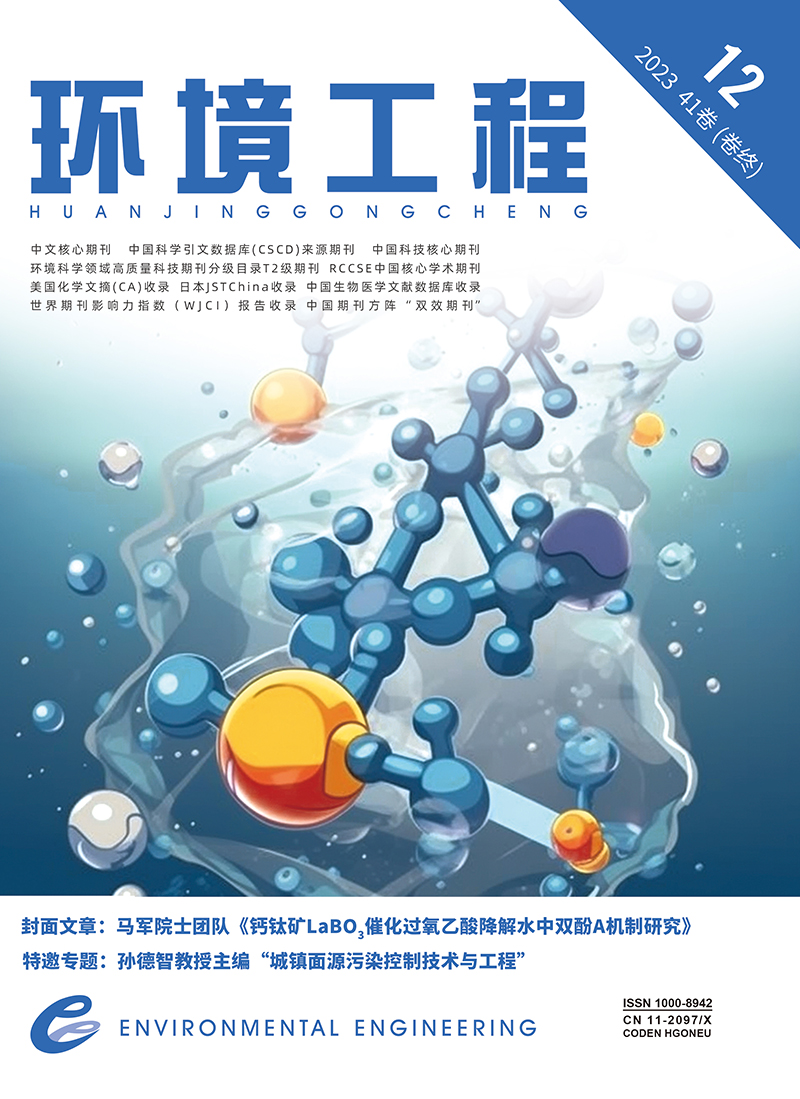| [1] |
石玉翠, 罗昕怡, 唐刚, 等. 人工湿地-微生物燃料电池耦合系统的研究进展及展望[J]. 环境工程, 2021, 39(8): 25-33.
|
| [2] |
WU Q, JIAO S P, MA M X, et al. Microbial fuel cell system: a promising technology for pollutant removal and environmental remediation[J]. Environmental Science and Pollution Research International, 2020, 27(7): 6749-6764.
|
| [3] |
陈婧, 秦歌, 余仁栋,等. 人工湿地-微生物燃料电池性能优化研究进展[J]. 水处理技术, 2022, 48(7): 25-31.
|
| [4] |
鹿钦礼, 李亮, 刘金亮, 等. 微生物燃料电池的应用研究进展[J]. 环境工程, 2019, 37(8): 95-100.
|
| [5] |
王义安, 王超, 林华, 等. 人工湿地与微生物燃料电池耦合系统的研究进展[J]. 现代化工, 2021, 41(3): 21-25.
|
| [6] |
陈传杰, 张铭川, 陈熙, 等. 核桃壳生物炭电极在微生物燃料电池中的产电性能及其对污染物的去除性能[J]. 环境工程学报, 2022, 16(10): 3281-3290.
|
| [7] |
KOFFI N J, OKABE S. Bioelectrochemical anoxic ammonium nitrogen removal by an MFC driven single chamber microbial electrolysis cell[J]. Chemosphere, 2021, 274: 129715.
|
| [8] |
夏函青, 伍永钢, 江文亭, 等. 人工湿地-微生物燃料电池系统的发展及展望[J]. 化工进展, 2019, 38(12): 5548-5556.
|
| [9] |
谢静怡, 卢学强, 李海笑. 人工湿地型微生物燃料电池研究进展述评[J]. 安全与环境学报, 2020, 20(1): 206-215.
|
| [10] |
LIU S T, FENG X J, XUE H P, et al. Bioenergy generation and nitrogen removal in a novel ecological-microbial fuel cell[J]. Chemosphere, 2021, 278: 130450.
|
| [11] |
CARMALIN A S, SREEJA S. Green energy generation from plant microbial fuel cells (PMFC) using compost and a novel clay separator[J]. Sustainable Energy Technologies and Assessments, 2017, 21: 59-66.
|
| [12] |
ASHEESH K Y, PURNANJALI D, AYUSMAN M, et al. Performance assessment of innovative constructed wetland-microbial fuel cell for electricity production and dye removal[J]. Ecological Engineering, 2012, 47: 126-131.
|
| [13] |
ABDULLAH A M, TAHEREH J, MAHAD S B, et al. Energy recovery and carbon/nitrogen removal from sewage and contaminated groundwater in a coupled hydrolytic-acidogenic sequencing batch reactor and denitrifying biocathode microbial fuel cell[J]. Environmental Research, 2020, 183: 10927-10938.
|
| [14] |
MOHAMED A, SAINAB F, SAMA A, et al. Continuous and scalable applications of microbial fuel cells: a critical review[J]. Reviews in Environmental Science and Bio/Technology, 2019, 18(3): 543-578.
|
| [15] |
黄珊, 陆勇泽, 朱光灿, 等. 耦合生物阴极SND的MLMB-MFC的构建与运行[J]. 化工学报, 2020, 71(4): 1772-1780.
|
| [16] |
王晋, 沈钱勇, 杨彦. 植物微生物燃料电池修复Cr(Ⅵ)污染湿地土壤及机理研究[J]. 环境科学学报, 2019, 39(2): 518-526.
|
| [17] |
李耀睿, 花修艺, 毛丹, 等. 颤蚓及其生物扰动对表层沉积物微环境pH和溶解氧的影响[J]. 吉林大学学报(理学版), 2015, 53(6): 1334-1340.
|
| [18] |
TOU, AZRI, SADI, et al. Chlorophytum microbial fuel cell characterization[J]. International Journal of Green Energy, 2019, 16(12): 947-959.
|
| [19] |
汪祝方, 赵志淼, 程梦雨, 等. 植物群落对湿地净化生活污水的影响[J]. 环境工程学报, 2021, 15(1): 126-135.
|
| [20] |
许丹, 黄铭意, 韩胡威, 等. 三种挺水植物对CW-MFC耦合系统脱氮及产电性能的影响[J]. 水生生物学报, 2023, 47(7): 1148-1156.
|
| [21] |
GARAI P, BANERJEE P, SHARMA P, et al. Nitrate-induced toxicity and potential attenuation of behavioural and stress biomarkers in Tubifex[J]. International Journal of Environmental Research, 2022, 16(4): 22-43.
|
| [22] |
XU F, CAO F Q, KONG Q, et al. Electricity production and evolution of microbial community in the constructed wetland-microbial fuel cell[J]. Chemical Engineering Journal, 2018, 339: 479-486.
|
| [23] |
SAZ Ç, TURE C, TURKER O C, et al. Effect of vegetation type on treatment performance and bioelectric production of constructed wetland modules combined with microbial fuel cell (CW-MFC) treating synthetic wastewater[J]. Environmental Science and Pollution Research, 2018, 25(9): 8777-8792.
|
| [24] |
WANG J F, SONG X S, WANG Y H, et al. Bioenergy generation and rhizodegradation as affected by microbial community distribution in a coupled constructed wetland-microbial fuel cell system associated with three macrophytes[J]. Science of the Total Environment, 2017, 607/608: 53-62.
|
| [25] |
OON Y L, ONG S A, HO L N, et al. Role of macrophyte and effect of supplementary aeration in up-flow constructed wetland-microbial fuel cell for simultaneous wastewater treatment and energy recovery[J]. Bioresource Technology, 2017, 224: 265-275.
|
| [26] |
HABIBUL N, HU Y, WANG Y K, et al. Bioelectrochemical chromium(Ⅵ) removal in plant-microbial fuel cells[J]. Environmental Science & Technology, 2016, 50(7): 3882-3890.
|
| [27] |
OON Y L, ONG S A, HO L N, et al. Hybrid system up-flow constructed wetland integrated with microbial fuel cell for simultaneous wastewater treatment and electricity generation[J]. Bioresource Technology, 2015, 186: 270-275.
|
| [28] |
WANG J, HOU J, XIA L, et al. The combined effect of dissolved oxygen and COD/N on nitrogen removal and the corresponding mechanisms in intermittent aeration constructed wetlands[J]. Biochemical Engineering Journal, 2020, 153(C): 107400-107409.
|
| [29] |
RACHNARIN N, ROSHAN R. Plant microbial fuel cells: a promising biosystems engineering[J]. Renewable and Sustainable Energy Reviews, 2017, 76: 81-89.
|
| [30] |
侯登峰, 张皓驰, 李先宁. 微生物燃料电池对废水脱氮性能的影响因素综述[J]. 环境污染与防治, 2022, 44(8): 1091-1096
, 1120.
|
| [31] |
HUANG X F, YE G Y, YI N K, et al. Effect of plant physiological characteristics on the removal of conventional and emerging pollutants from aquaculture wastewater by constructed wetlands[J]. Ecological Engineering, 2019, 135: 45-53.
|
| [32] |
张克, 田双超, 窦雪雁, 等. 厌氧/好氧生物接触氧化工艺耦合微生物燃料电池技术处理农村生活污水[J]. 环境工程, 2022, 40(3): 139-146.
|


 Login
Login Register
Register E-alert
E-alert






 DownLoad:
DownLoad: